SCM631
Additional Topics in Warehouse
Management
SAP ERP Procurement and Logistics Execution
Date
Training Center
Instructors
Education Website
Participant Handbook
Course Version: 73
Course Duration: 2 Days
Material Number: 50086979
An SAP course - use it to learn, reference it for work
�
Copyright
Copyright ' 2008 SAP AG. All rights reserved.
No part of this publication may be reproduced or transmitted in any form or for any purpose
without the express permission of SAP AG. The information contained herein may be changed
without prior notice.
Some software products marketed by SAP AG and its distributors contain proprietary software
components of other software vendors.
Trademarks
Microsoftfi, WINDOWSfi, NTfi, EXCELfi, Wordfi, PowerPointfi and SQL Serverfi are
registered trademarks of Microsoft Corporation.
IBMfi, DB2fi, OS/2fi, DB2/6000fi, Parallel Sysplexfi, MVS/ESAfi, RS/6000fi, AIXfi,
S/390fi, AS/400fi, OS/390fi, and OS/400fi are registered trademarks of IBM Corporation.
ORACLEfi is a registered trademark of ORACLE Corporation.
INFORMIXfi-OnLine for SAP and INFORMIXfi Dynamic ServerTM are registered
trademarks of Informix Software Incorporated.
UNIXfi, X/Openfi, OSF/1fi, and Motiffi are registered trademarks of the Open Group.
Citrixfi, the Citrix logo, ICAfi, Program Neighborhoodfi, MetaFramefi, WinFramefi,
VideoFramefi, MultiWinfi and other Citrix product names referenced herein are trademarks
of Citrix Systems, Inc.
HTML, DHTML, XML, XHTML are trademarks or registered trademarks of W3Cfi, World
Wide Web Consortium, Massachusetts Institute of Technology.
JAVAfi is a registered trademark of Sun Microsystems, Inc.
JAVASCRIPTfi is a registered trademark of Sun Microsystems, Inc., used under license for
technology invented and implemented by Netscape.
SAP, SAP Logo, R/2, RIVA, R/3, SAP ArchiveLink, SAP Business Workflow, WebFlow, SAP
EarlyWatch, BAPI, SAPPHIRE, Management Cockpit, mySAP.com Logo and mySAP.com
are trademarks or registered trademarks of SAP AG in Germany and in several other countries
all over the world. All other products mentioned are trademarks or registered trademarks of
their respective companies.
Disclaimer
THESE MATERIALS ARE PROVIDED BY SAP ON AN "AS IS" BASIS, AND SAP EXPRESSLY
DISCLAIMS ANY AND ALL WARRANTIES, EXPRESS OR APPLIED, INCLUDING
WITHOUT LIMITATION WARRANTIES OF MERCHANTABILITY AND FITNESS FOR A
PARTICULAR PURPOSE, WITH RESPECT TO THESE MATERIALS AND THE SERVICE,
INFORMATION, TEXT, GRAPHICS, LINKS, OR ANY OTHER MATERIALS AND PRODUCTS
CONTAINED HEREIN. IN NO EVENT SHALL SAP BE LIABLE FOR ANY DIRECT,
INDIRECT, SPECIAL, INCIDENTAL, CONSEQUENTIAL, OR PUNITIVE DAMAGES OF ANY
KIND WHATSOEVER, INCLUDING WITHOUT LIMITATION LOST REVENUES OR LOST
PROFITS, WHICH MAY RESULT FROM THE USE OF THESE MATERIALS OR INCLUDED
SOFTWARE COMPONENTS.
g200821242125
�
About This Handbook
This handbook is intended to complement the instructor-led presentation of this
course, and serve as a source of reference. It is not suitable for self-study.
Typographic Conventions
American English is the standard used in this handbook. The following
typographic conventions are also used.
Type Style
Example text
Example text
EXAMPLE TEXT
Example text
Example text
Description
Words or characters that appear on the screen. These
include field names, screen titles, pushbuttons as well
as menu names, paths, and options.
Also used for cross-references to other documentation
both internal (in this documentation) and external (in
other locations, such as SAPNet).
Emphasized words or phrases in body text, titles of
graphics, and tables
Names of elements in the system. These include
report names, program names, transaction codes, table
names, and individual key words of a programming
language, when surrounded by body text, for example
SELECT and INCLUDE.
Screen output. This includes file and directory names
and their paths, messages, names of variables and
parameters, and passages of the source text of a
program.
Exact user entry. These are words and characters that
you enter in the system exactly as they appear in the
documentation.
Variable user entry. Pointed brackets indicate that you
replace these words and characters with appropriate
entries.
2008
' 2008 SAP AG. All rights reserved.
iii
�
About This Handbook
SCM631
Icons in Body Text
The following icons are used in this handbook.
Icon
Meaning
For more information, tips, or background
Note or further explanation of previous point
Exception or caution
Procedures
Indicates that the item is displayed in the instructor’s
presentation.
iv
' 2008 SAP AG. All rights reserved.
2008
�
Contents
Course Overview ......................................................... vii
Course Goals ...........................................................vii
Course Objectives .....................................................vii
Unit 1: Storage Unit Management...................................... 1
Storage Unit Management.............................................2
Storage Unit Management in Bulk Storage........................ 18
Handling Unit Management.......................................... 31
Unit 2: Hazardous Material Management........................... 39
Hazardous Material Handling ....................................... 40
Unit 3: Additional Functions in TO Processing................... 53
Determining the Planned Data and Entering the Actual Data... 54
Transfer Order Split................................................... 59
Unit 4: Mobile Data Entry .............................................. 63
Mobile Data Entry - Technical Implementation .................... 64
Mobile Data Entry - Customizing.................................... 68
Unit 5: Connection of Warehouse Control Units ................. 89
The Technical Connection to a Warehouse Control Unit ........ 90
Using a Warehouse Control Unit - Scenarios ..................... 94
Unit 6: Decentralized Warehouse Management and Technical
Themes ..................................................................... 99
Decentralized Warehouse Management..........................100
Technical Topics......................................................108
Index ....................................................................... 115
2008
' 2008 SAP AG. All rights reserved.
v
�
Contents
SCM631
vi
' 2008 SAP AG. All rights reserved.
2008
�
Course Overview
This course explains the various settings in Warehouse Management that can
be used to optimize warehouse processes. This primarily involves Storage Unit
Management and mobile data entry within the warehouse. In addition, this
course discusses the settings for hazardous material management and using the
decentralized Warehouse Management system.
Target Audience
This course is intended for the following audiences:
Project team members
Course Prerequisites
Required Knowledge
SCM630 Warehouse Management
Course Goals
This course will prepare you to:
Gain an understanding of the additional topics in the SAP Warehouse
Management system and the Customizing options that are available for
special company requirements.
put your knowledge into practice by completing specially selected exercises
in an online system.
Course Objectives
After completing this course, you will be able to:
Perform functions such as Customizing of Storage Unit Management, radio
frequency, and hazardous material management.
Describe the Customizing options and settings in the Warehouse
Management system for Handling Unit Management, decentralized
Warehouse Management, and performance data.
2008
' 2008 SAP AG. All rights reserved.
vii
�
Course Overview
SCM631
viii
' 2008 SAP AG. All rights reserved.
2008
�
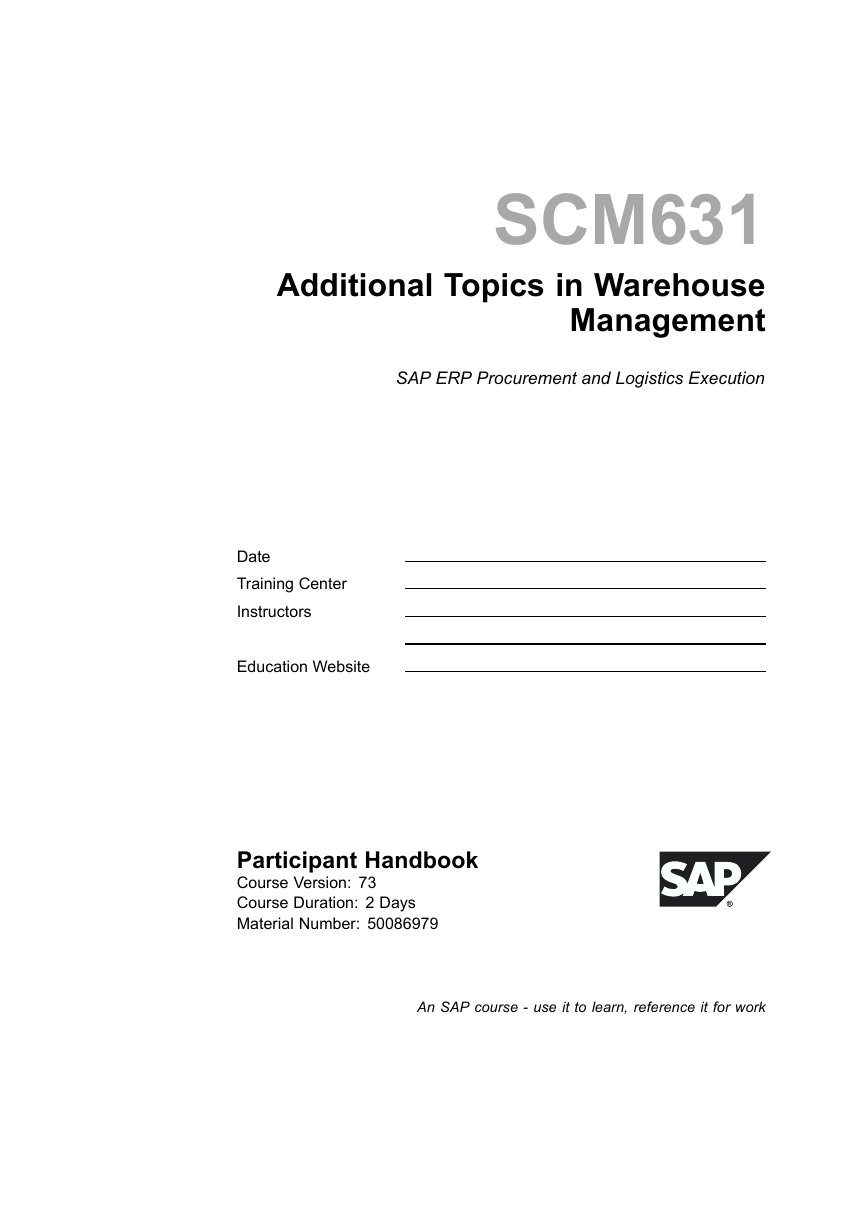
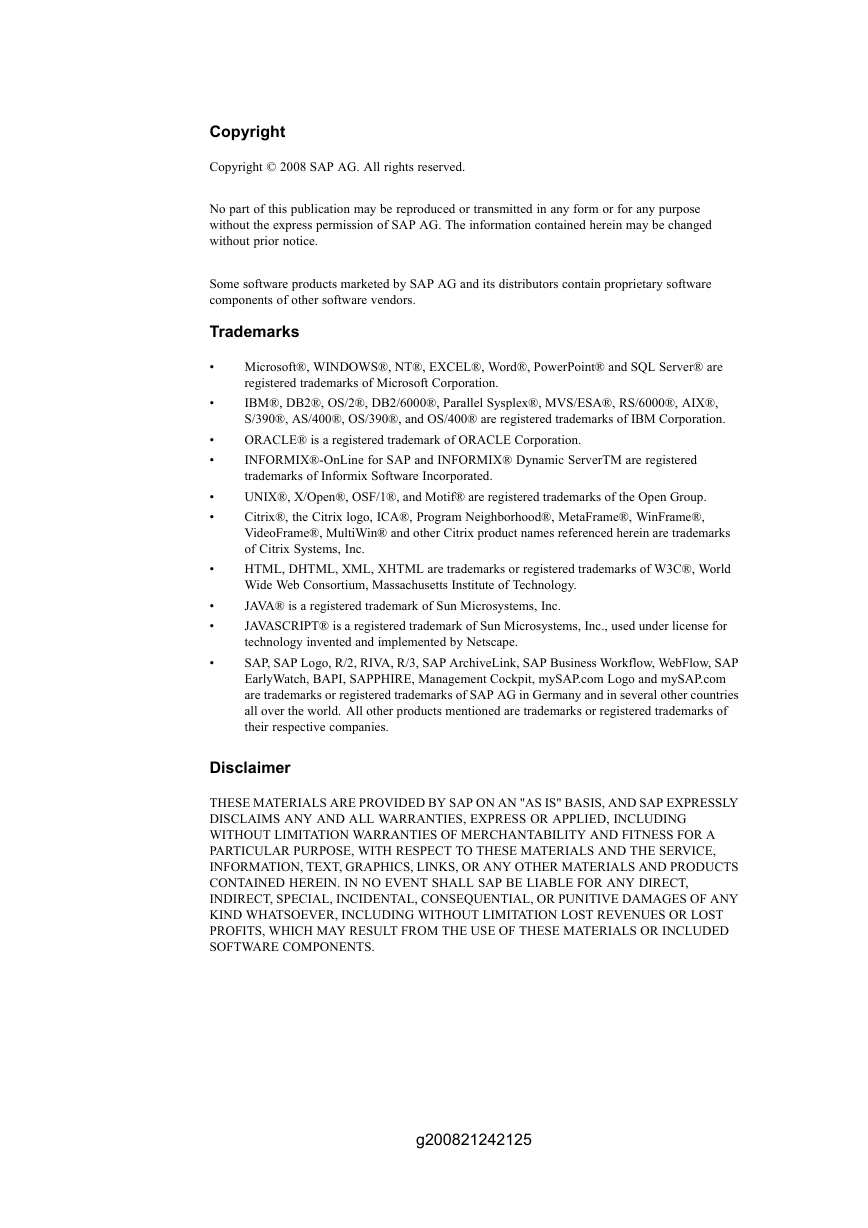
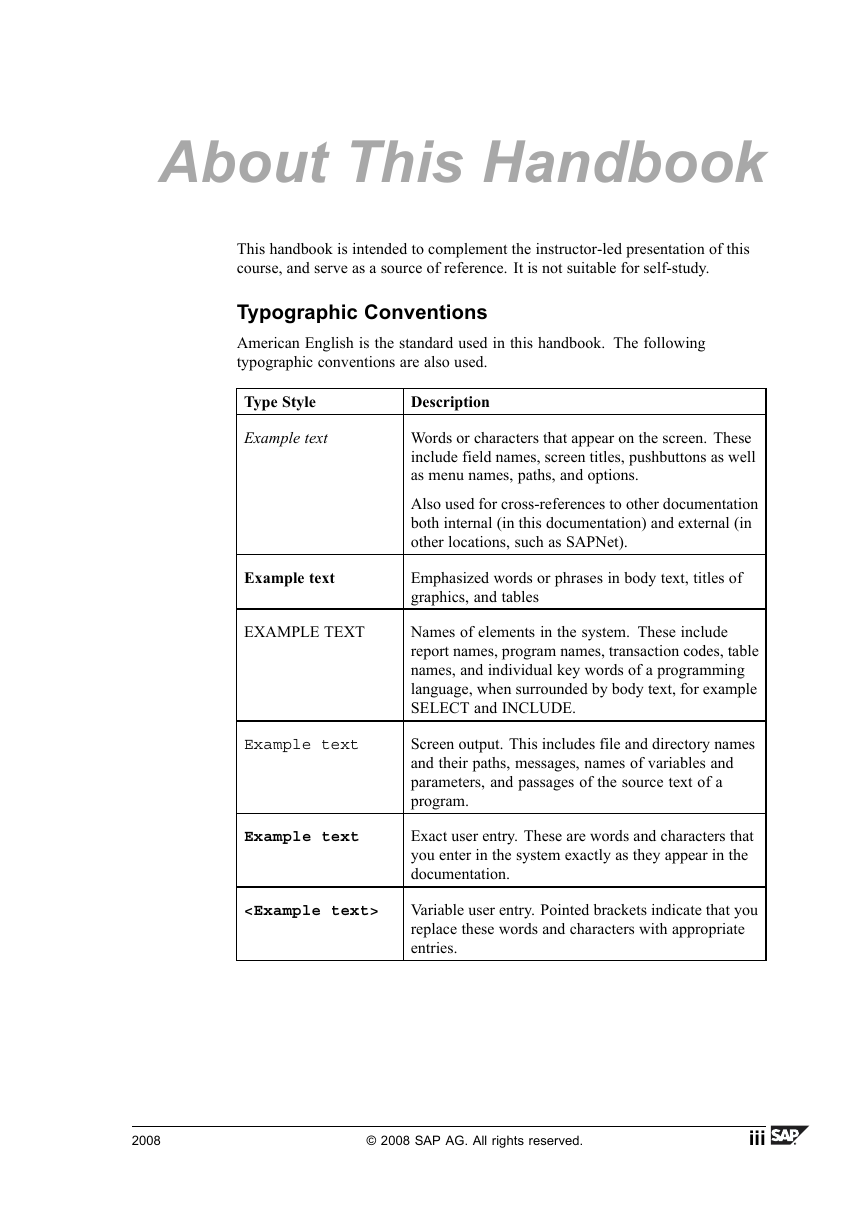

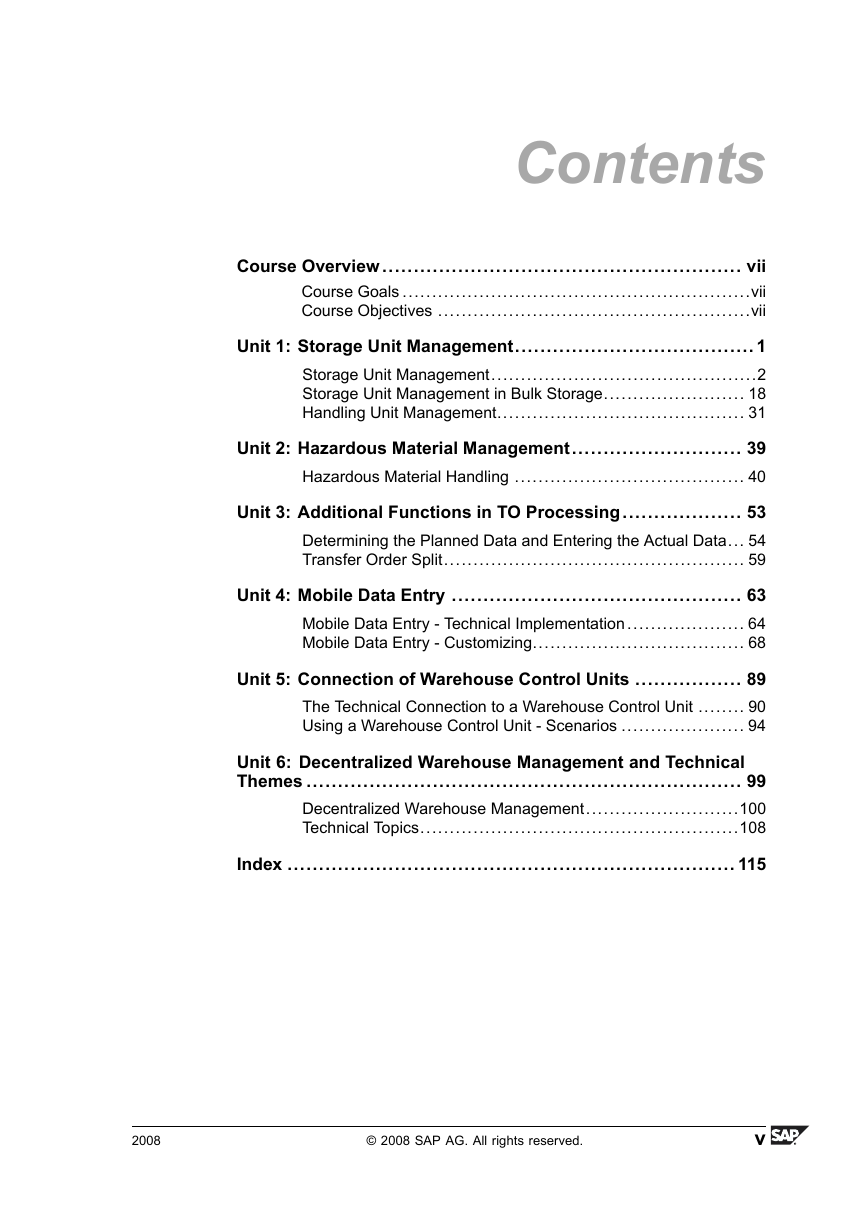

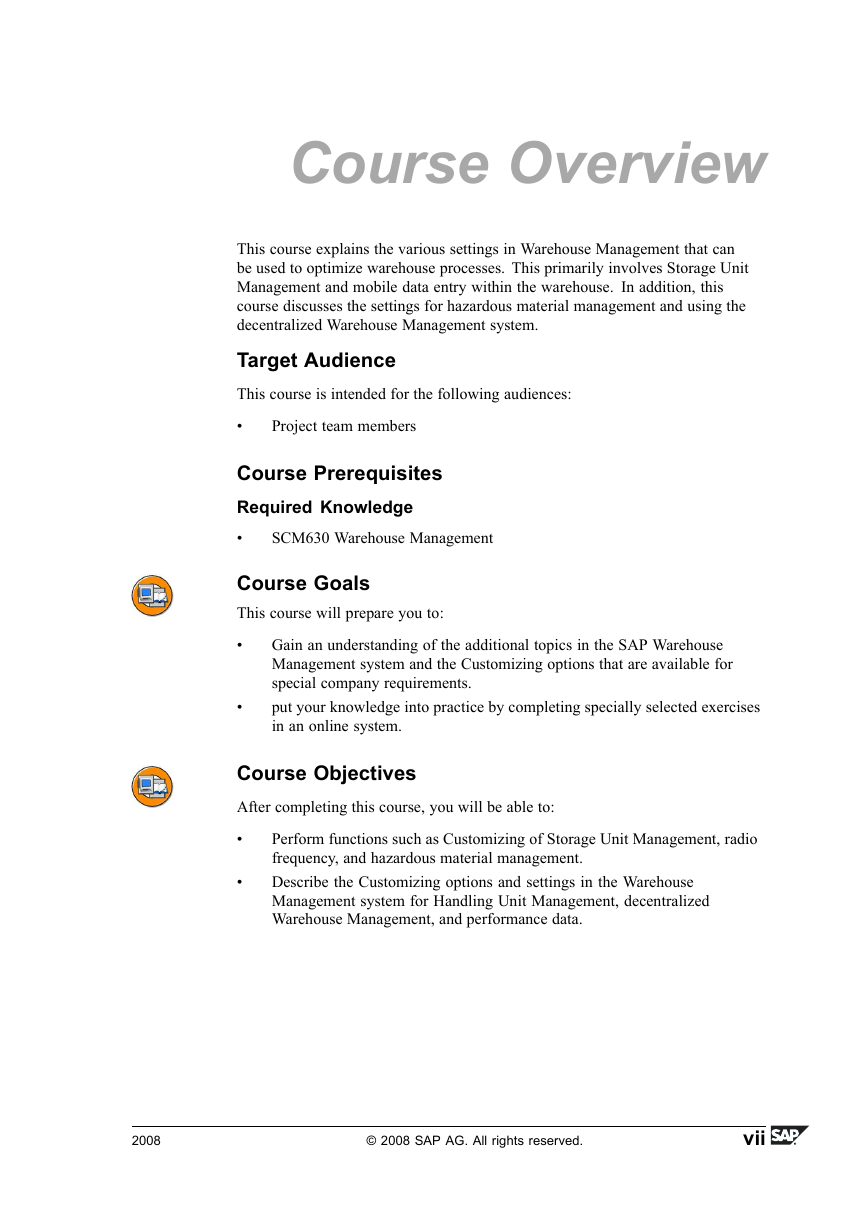









 2023年江西萍乡中考道德与法治真题及答案.doc
2023年江西萍乡中考道德与法治真题及答案.doc 2012年重庆南川中考生物真题及答案.doc
2012年重庆南川中考生物真题及答案.doc 2013年江西师范大学地理学综合及文艺理论基础考研真题.doc
2013年江西师范大学地理学综合及文艺理论基础考研真题.doc 2020年四川甘孜小升初语文真题及答案I卷.doc
2020年四川甘孜小升初语文真题及答案I卷.doc 2020年注册岩土工程师专业基础考试真题及答案.doc
2020年注册岩土工程师专业基础考试真题及答案.doc 2023-2024学年福建省厦门市九年级上学期数学月考试题及答案.doc
2023-2024学年福建省厦门市九年级上学期数学月考试题及答案.doc 2021-2022学年辽宁省沈阳市大东区九年级上学期语文期末试题及答案.doc
2021-2022学年辽宁省沈阳市大东区九年级上学期语文期末试题及答案.doc 2022-2023学年北京东城区初三第一学期物理期末试卷及答案.doc
2022-2023学年北京东城区初三第一学期物理期末试卷及答案.doc 2018上半年江西教师资格初中地理学科知识与教学能力真题及答案.doc
2018上半年江西教师资格初中地理学科知识与教学能力真题及答案.doc 2012年河北国家公务员申论考试真题及答案-省级.doc
2012年河北国家公务员申论考试真题及答案-省级.doc 2020-2021学年江苏省扬州市江都区邵樊片九年级上学期数学第一次质量检测试题及答案.doc
2020-2021学年江苏省扬州市江都区邵樊片九年级上学期数学第一次质量检测试题及答案.doc 2022下半年黑龙江教师资格证中学综合素质真题及答案.doc
2022下半年黑龙江教师资格证中学综合素质真题及答案.doc